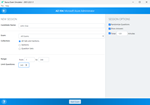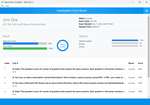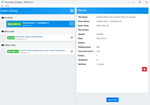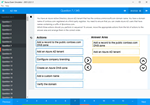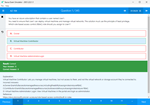Download Oracle Exadata X3 and X4 Administration.1z0-027.CertDumps.2017-12-14.72q.tqb
| Vendor: | Oracle |
| Exam Code: | 1z0-027 |
| Exam Name: | Oracle Exadata X3 and X4 Administration |
| Date: | Dec 14, 2017 |
| File Size: | 2 MB |
How to open TQB files?
Files with TQB (Taurus Question Bank) extension can be opened by Taurus Exam Studio.
Purchase
Coupon: TAURUSSIM_20OFF
Discount: 20%
Demo Questions
Question 1
To troubleshoot a possible hardware problem, you consider moving all disk drives from one Exadata storage server to a replacement chassis.
You must contain storage availability while performing task.
The Exadata storage server is an X3-8 Database Machine and storage grid is not partitioned.
Which two factors would prevent you from moving the disks from one Exadata storage server to another one?
- The existence of an external redundancy ASM diskgroup
- The existence of a normal redundancy ASM diskgroup
- The existence of an ASM diskgroup with the repair_time attribute set to 0.
- The existence of an ASM diskgroup with its compatible.asm attribute set to 10.2.0.0.0
- Offline or inactive celldisks in another Exadata server
Correct answer: AD
Explanation:
A: If you want Oracle ASM to mirror files, specify the redundancy level as NORMAL REDUNDANCY (2-way mirroring by default for most file types) or HIGH REDUNDANCY (3-way mirroring for all files). You specify EXTERNAL REDUNDANCY if you do not want mirroring by Oracle ASM. For example, you might choose EXTERNAL REDUNDANCY if you want to use storage array protection features.D: Restoring the redundancy of an Oracle ASM disk group after a transient disk path failure can be time consuming. This is especially true if the recovery process requires rebuilding an entire Oracle ASM failure group. Oracle ASM fast mirror resync significantly reduces the time to resynchronize a failed disk in such situations. When you replace the failed disk, Oracle ASM can quickly resynchronize the Oracle ASM disk extents.To use this feature, the disk group compatibility attributes must be set to 11.1 or higher. Incorrect:Not C: You can set the DISK_REPAIR_TIME disk group attribute to delay the drop operation by specifying a time interval to repair the disk and bring it back online. Note:* The redundancy levels are:/ External redundancy Oracle ASM does not provide mirroring redundancy and relies on the storage system to provide RAID functionality. Any write error cause a forced dismount of the disk group. All disks must be located to successfully mount the disk group. / Normal redundancy Oracle ASM provides two-way mirroring by default, which means that all files are mirrored so that there are two copies of every extent. A loss of one Oracle ASM disk is tolerated. You can optionally choose three-way or unprotected mirroring. / High redundancy Oracle ASM provides triple mirroring by default. A loss of two Oracle ASM disks in different failure groups is tolerated. Reference: Administering Oracle ASM Disk Groups A: If you want Oracle ASM to mirror files, specify the redundancy level as NORMAL REDUNDANCY (2-way mirroring by default for most file types) or HIGH REDUNDANCY (3-way mirroring for all files). You specify EXTERNAL REDUNDANCY if you do not want mirroring by Oracle ASM. For example, you might choose EXTERNAL REDUNDANCY if you want to use storage array protection features.
D: Restoring the redundancy of an Oracle ASM disk group after a transient disk path failure can be time consuming. This is especially true if the recovery process requires rebuilding an entire Oracle ASM failure group. Oracle ASM fast mirror resync significantly reduces the time to resynchronize a failed disk in such situations. When you replace the failed disk, Oracle ASM can quickly resynchronize the Oracle ASM disk extents.
To use this feature, the disk group compatibility attributes must be set to 11.1 or higher.
Incorrect:
Not C: You can set the DISK_REPAIR_TIME disk group attribute to delay the drop operation by specifying a time interval to repair the disk and bring it back online.
Note:
* The redundancy levels are:
/ External redundancy
Oracle ASM does not provide mirroring redundancy and relies on the storage system to provide RAID functionality. Any write error cause a forced dismount of the disk group. All disks must be located to successfully mount the disk group.
/ Normal redundancy
Oracle ASM provides two-way mirroring by default, which means that all files are mirrored so that there are two copies of every extent. A loss of one Oracle ASM disk is tolerated. You can optionally choose three-way or unprotected mirroring.
/ High redundancy
Oracle ASM provides triple mirroring by default. A loss of two Oracle ASM disks in different failure groups is tolerated.
Reference: Administering Oracle ASM Disk Groups
Question 2
Which two are regarding the case of storage indexes?
- To increase the chance of using the a storage index, you can make table indexes invisible.
- To maximize the benefit of storage Indexes, load your data stored on the filtered columns.
- The cell physical 10 bytes saved by storage index statistic returns multiple rows, one for each storage server.
- Storage indexes are retained after a cell is rebooted.
- Avoid the use of bind variables because Storage Indexes do not work with bind variables.
Correct answer: AB
Explanation:
To use storage indexes, Oracle Exadata queries must use smart scans, so not all types of applications can benefit from storage indexes. * With Exadata storage, database operations are handled much more efficiently. Queries that perform table scans can be processed within Exadata storage with only the required subset of data returned to the database server. Row filtering, column filtering and some join processing (among other functions) are performed within the Exadata storage cells. When this takes place only the relevant and required data is returned to the database server. To use storage indexes, Oracle Exadata queries must use smart scans, so not all types of applications can benefit from storage indexes.
* With Exadata storage, database operations are handled much more efficiently. Queries that perform table scans can be processed within Exadata storage with only the required subset of data returned to the database server. Row filtering, column filtering and some join processing (among other functions) are performed within the Exadata storage cells. When this takes place only the relevant and required data is returned to the database server.
Question 3
Identity the resource bottleneck for which QoS Management can generate recommendation?
- CPU resource bottlenecks
- Global Cache resource bottlenecks
- I/O resource bottlenecks
- Network resource bottlenecks
Correct answer: A
Question 4
Which two are Oracle recommendations for media based backups performed for a database running on a Database Machine?
- Allocate equivalent number of channels and instances per tape drive.
- Perform periodic level 0 backups and daily cumulative level-1 backups.
- Use the InfiniBand network between the database server and media server.
- Configure Recovery Manager (RMAN) channels to connect to the least loaded instances.
- Use InfiniBand network between the media server and the storage servers.
Correct answer: AC
Explanation:
A: Configure one RMAN channel per tape drive and add tape drives to scale backup rates.C: Configure the Preferred Network Interface (PNI) to direct the Oracle Secure Backuptraffic over the InfiniBand network interface. Example:ob> lspni (List Preferred Network Interface) mediaserver1:PNI 1:interface: mediaserver1-ibclients: dbnode1, dbnode2, dbnode3, dbnode4, dbnode5, dbnode6, dbnode7, dbnode8 PNI 2:interface: mediaserver1clients: adminserver dbnode1:PNI 1:interface: dbnode1-ibclients: mediaserver1Note:* Using the Sun ZFS Backup Appliance as an Oracle RMAN backup target for an Oracle Exadata system delivers much faster backup and recovery, enabling organizations to achieve shorter recovery time objectives and shrink backup windows. The appliance is designed for high sustained read and write I/O performance, and it is connected to the Oracle Exadata system via a high-throughput InfiniBand network fabric. * As the only unified storage vendor to support InfiniBand as a storage network for backup and restore operations, Oracle is leading the way with native high-bandwidth interconnects. * The InfiniBand network provides 40 Gb of bandwidth per port between the database servers, storage cells, and the Sun ZFS Backup Appliance. Backup and restore operations can be automatically parallelized across all database nodes, Oracle Exadata storage cells, Sun ZFS Backup Appliance channels, and controllers. A: Configure one RMAN channel per tape drive and add tape drives to scale backup rates.
C: Configure the Preferred Network Interface (PNI) to direct the Oracle Secure Backup
traffic over the InfiniBand network interface.
Example:
ob> lspni (List Preferred Network Interface)
mediaserver1:
PNI 1:
interface: mediaserver1-ib
clients: dbnode1, dbnode2, dbnode3, dbnode4,
dbnode5, dbnode6, dbnode7, dbnode8
PNI 2:
interface: mediaserver1
clients: adminserver
dbnode1:
PNI 1:
interface: dbnode1-ib
clients: mediaserver1
Note:
* Using the Sun ZFS Backup Appliance as an Oracle RMAN backup target for an Oracle Exadata system delivers much faster backup and recovery, enabling organizations to achieve shorter recovery time objectives and shrink backup windows. The appliance is designed for high sustained read and write I/O performance, and it is connected to the Oracle Exadata system via a high-throughput InfiniBand network fabric.
* As the only unified storage vendor to support InfiniBand as a storage network for backup and restore operations, Oracle is leading the way with native high-bandwidth interconnects.
* The InfiniBand network provides 40 Gb of bandwidth per port between the database servers, storage cells, and the Sun ZFS Backup Appliance. Backup and restore operations can be automatically parallelized across all database nodes, Oracle Exadata storage cells, Sun ZFS Backup Appliance channels, and controllers.
Question 5
What is the benefit of bonding the client access network configuration?
- Improved performance
- Improved reliability
- Both improved performance and reliability
- A Single Client Access Name (SCAN)
- Improved monitoring
Correct answer: B
Explanation:
Reference: Oracle Exadata Database Machine - Backup & Recovery Sizing: Tape Backups Reference: Oracle Exadata Database Machine - Backup & Recovery Sizing: Tape Backups
HOW TO OPEN VCE FILES
Use VCE Exam Simulator to open VCE files

HOW TO OPEN VCEX FILES
Use ProfExam Simulator to open VCEX files


ProfExam at a 20% markdown
You have the opportunity to purchase ProfExam at a 20% reduced price
Get Now!